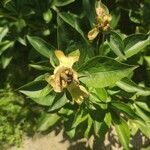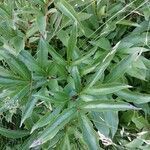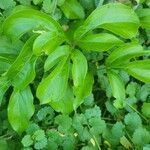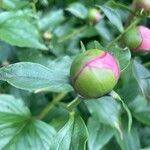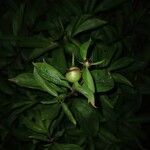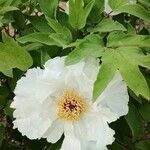Herbs perennial, to 70 cm tall. Roots thick, attenuate toward tip, to 1.3 cm in diam. Stems glabrous. Proximal leaves 2-ternate; all leaflets decurrent at base, terminal ones often 2-or 3-segmented; leaflets and segments up to 15, lanceolate or ovate-lanceolate, 4.5--16 × 1.5--4.8 cm, sparsely pubescent abaxially, bristly along veins adaxially, margin white cartilaginous denticulate, apex acuminate. Flowers usually several per shoot, both terminal and axillary, sometimes only terminal one developed, single (in wild plants) or double (in cultivated plants), 8--13 cm wide. Bracts 4 or 5, lanceolate, unequal. Sepals 3 or 4, broadly ovate or suborbicular, 1--1.5 × 1--1.7 cm. Petals 9--13, white or pink (in wild plants), or varying in color (in cultivated plants), obovate, 3.5--6 × 1.5--4.5 cm. Filaments yellow, 0.7--1.2 cm; anthers yellow. Disc yellow, annular. Carpels 2--5, green or purple, glabrous or rarely tomentose. Follicles oblong-ellipsoid, 2.5--3 × 1.2--1.5 cm. Fl. May--Jun, fr. Aug. 2n = 10.
More
A perennial plant up to 75 m high. It spread to 50 cm across. The stems are erect. The leaves have lobes and are pointed. The flowers are large and pink or white. They have a scent. The flowers are 10 cm across. There are 2 or more per stem. There are now many cultivated varieties.
Plants are grown from seed and fresh seed should be used, as stored seed takes a long time to germinate. Plants do not like root disturbance. Transplanting or division of the root should be done very carefully.
